| |
|
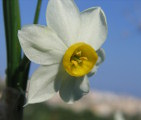 | |
| MaltaWildPlants.com by Stephen Mifsud |

|
| |
|
|
 |  |  |  |
| External Links: |
|
Hirschfeldia incana (Hoary Mustard) |
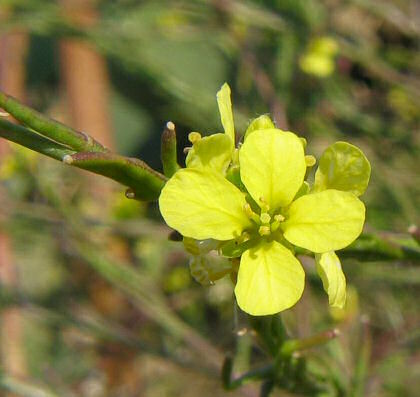
Hirschfeldia incana (BRASSICACEAE.)
Images for this profile are taken from the Maltese Islands after year 2000. |
|
| Nomenclature |
Species name : | Hirschfeldia incana (L.) Lagr.-Foss. | Authority : | Carl von Linne, Sweden, (1707 - 1778) ;
Adrian Rose Arnaud Lagreze-Fossat, France, (1818 - 1874) | Synonyms :
(basionym or principal syn.) |
|
Plant Family : | Brassicaceae Juss. (= Cruciferae )
(Mustard or Cress Family) | English name(s) : | Hoary Mustard, Short-podded Mustard, Buchan Weed | Maltese name(s) : | Mustarda selvaġġa | Status for Malta : | Doubtful origin. It is not yet established if this species is native or not. | Name Derivation : |
Hirschfeldia: Named after German horticulturist Christian Caius Lorenz Hirschfeld (1742-1792). (Latin origin ); 2 = Named after German horticulturist Christian Caius Lorenz Hirschfeld (1742-1792) (Latin).
incana: greyish or hoary for the presence of short, dense, greyish-white hairs. (Latin origin ); 2 = grayish or hoary with ref of its short, dense, grayish white hairs. (Latin).
| Remarks : | |
|
| Morphology and structure |
PLANT STRUCTURE: |
Character | Growth Form | Branching | Surface |
Description | | | |
General
Picture |  |  | 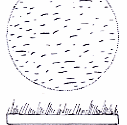 |
|
LEAVES: |
Character | Arrangement | Attachment | Venation |
Description | | | |
General
Picture | 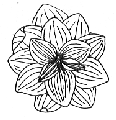 | 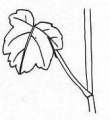 |  |
| |
Character | Leaf Shape | Leaf Margin | Remarks |
Description | | | Leaf Lobes Rounded, with a blunt apex. |
General
Picture |  | 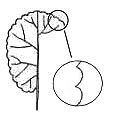 |  |
|
FLOWERS: |
Character | Colour | Basic Flower Type | No. of Petals | No. of Sepals |
Description | Pale Yellow Sometimes described as Sulphur yellow. | | 4 | 4 |
General
Picture | | 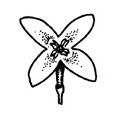 |  |  |
| |
Character | Inflorescence | Description | Ovary | Stamens |
Description | | The plant forms small clusters of yellow flowers at the apex of the flowering stems. Every flower consists of 4 oval, non-overlapping yellow petals arranged diagonally to each other, 6 stamens and a central pistil. When young the flowers are cup shaped, but with time the petals spread out like the shape of a cross. | | |
General
Picture |  |  | 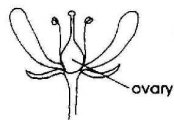 | 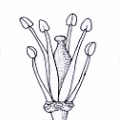 |
| |
Character | Scent | Average Flower Size | Pollen Colour | Other Notes |
Description | None | 8mm | Pale Yellow | - |
|
SEEDS: |
Character | No. Per Fruit | Shape | Size | Colour |
Description | 6-10 | Cylindrical (more or less ike the shape of a barrel. | 1mm | Reddish Brown |
General
Picture |  |  |  |  |
|
FRUIT AND OTHER BOTANICAL DATA: |
Character | Fruit Type | Colour of Fruit | Subterranean Parts | Other Notes |
Description | | Green to pale brown | | Stem Branching The plant has an extensive stem branching which may look like a small leafless bush. |
General
Picture |  |  |  |  |
|
|
| Plant description and characters | |
Life Cycle: | Annual (sometimes biennial). |
Growth Form: | HEMICRYPTOPHYTE (prostate plants with flowers close to the ground) |
Habitat: | Waste ground and disturbed areas near arable land, countryside paths, sometimes in field margins. |
Frequency: | Common |
Localities in Malta: | Found in several countryside paths, for example in Dingli, Ghakn Tuffieha, Siggiewi and Qormi. |
Plant Height: | 40-100cm. |
| Feb-May |
Protection in Malta: | Not legally protected till the last update of this website (2/Mar/2022) |
Red List 1989: | Not listed in the Red Data Book of the Maltese Islands |
Poison: | |
This annual plant is seen growing mostly along rocky roadsides in the countryside, field paths or wasteground near arable sites. When young, the plant forms a basal rosette, but later the mature plant produces a multi-branched flowering stem with smaller cauline leaves. In Malta, many of the leaves are lost during the late-flowering and fruiting stage (May-June) and so the general appearance of the adult plants is that of a highly branched 'bush' with little leaves and plenty of small bright yellow flowers at the branches' tips. The stems are covered with short, greyish hairs, (= canascent).
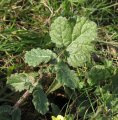 The leaves of the basal rosette can reach 20-30ccm in length, and are pinnatisect (lobes cut up to the midrib) with 2-7 pairs of lateral lobes. The lateral lobes are oblong to ovate with a rounded tip, while the apical lobe is lanceolate with a blunt-pointed tip. The cauline leaves are shorter, with less lateral lobes (up to 4 pairs) towards the leaf base or without lobes in the uppermost leaves. The lateral lobes of the upper leaves are more slender and lanceolate, while the apical lobe is very large, ovate to lance-shaped with a blunt tip. The uppermost leaves at the flowering branches are reduced to relatively small, subsessile, narrow-lanceolate, lobed leaves. The margin of all leaves are crenated or with shallow teeth and show pinnate venation. The leaves of the basal rosette can reach 20-30ccm in length, and are pinnatisect (lobes cut up to the midrib) with 2-7 pairs of lateral lobes. The lateral lobes are oblong to ovate with a rounded tip, while the apical lobe is lanceolate with a blunt-pointed tip. The cauline leaves are shorter, with less lateral lobes (up to 4 pairs) towards the leaf base or without lobes in the uppermost leaves. The lateral lobes of the upper leaves are more slender and lanceolate, while the apical lobe is very large, ovate to lance-shaped with a blunt tip. The uppermost leaves at the flowering branches are reduced to relatively small, subsessile, narrow-lanceolate, lobed leaves. The margin of all leaves are crenated or with shallow teeth and show pinnate venation.
The flowers are typical of the cress (Cruciferae) family. They grow in long racemes and consist of 4 small sepals, 4 yellow petals arranged as a cross, 6 stamens (4 long and central / 2 short and lateral) and one central style+stigma. The flower size varies from 6mm to 12mm in diameter, and found as a dense cluster just at the branch tips. Despite the flowers are small, they are still somehow conspicuous since of the large number of flowering branches, their bright yellow colour and lack of large leaves during the flowering period.
 The orientation and shape of the fruit pods (called siliqua) also help to maintain flowers conspicuous. The fruit pods are only about 10-12mm long and so much appressed to their flowering stem, that they are not not distinctly visible. The siliqua are glabrous, often with longitudinal veins (up to 3 per valve) and with a conspicuous swollen, lanceolate beak which holds 1 seed. Siliqua may contain 6-10 reddish brown seeds of about 1 mm in size and a rounded to cylindrical shape. The orientation and shape of the fruit pods (called siliqua) also help to maintain flowers conspicuous. The fruit pods are only about 10-12mm long and so much appressed to their flowering stem, that they are not not distinctly visible. The siliqua are glabrous, often with longitudinal veins (up to 3 per valve) and with a conspicuous swollen, lanceolate beak which holds 1 seed. Siliqua may contain 6-10 reddish brown seeds of about 1 mm in size and a rounded to cylindrical shape.
|
|
| Information, uses and other details |
Nativity and distribution
The distributional range and nativity of this plant is shown in the list below: [WWW-26]
Northern Africa: Algeria [n.]; Libya [n.]; Morocco; Tunisia
Western Asia: Cyprus; Iran; Iraq; Israel; Jordan; Lebanon; Syria; Turkey
Caucasus: Azerbaijan; Russian Federation - Dagestan
Europe: Albania; Greece (incl. Crete); Italy (incl. Sardinia, Sicily); Yugoslavia; France (incl. Corsica); Ukraine (incl. Krym); Portugal (incl. Azores, Madeira Islands); Spain (incl. Canary Islands, Baleares)
Edible Uses
The young plant is eaten with oil and lemon juice in parts of Greece[183]. The leaves of young plants are eaten raw[61, 177].
Seeds are consumed raw or cooked [257]. They can be ground into powder then mixed with water and eaten[257].
Factors affecting accumulation of thallium and other trace elements in two wild Brassicaceae spontaneously growing on soils contaminated by tailings dam waste.
Thallium is a scarce, highly toxic element. There are several investigations that report Tl accumulation in plants of the family Brassicaceae. These plants could pose a risk in areas where Tl is present at higher concentrations than normal soils. The present study reports analyses of two wild Brassicaceae, Hirschfeldia incana and Diplotaxis catholica, growing spontaneously at five sampling sites moderately polluted with Tl and other trace elements in the Green Corridor of the Guadiamar river, Seville, S. Spain. In general, trace element content was unremarkable in all part plants, despite the concentrations present in soil. Thallium was the only element whose concentration in both plant species was above normal for plants (maximum values of 5.00 mgkg(-1) in H. incana flowers). There were significant positive correlations between total Tl in soil and Tl in both plant species. Transfer Coefficients (TC) for all elements were, in general, for both species, except for Tl in flowers and fruits at some sites. The highest Enrichment Factor (EF) was found for Tl in H. incana fruits (EF = 607) and D. catholica flowers (EF = 321). H. incana was studied in a previous growing season (2004) in the same area, although the rainfall was 3 times more than in the year of the present study (2005), giving a maximum Tl content of 46.5 mgkg(-1) in H. incana flowers. The data presented here show that Tl content of plants growing in semi-arid conditions can be significantly influenced by precipitation. In dry years, plant Tl accumulation may be significantly reduced. [321]
Personal Observations
Identification remarks
The short appressed pods of the plant looks similar to a closely related plant - the Hirschfeldia incana and hence one can easily confuse the two plants. Below is a table which illustrates the main differences betwenn H. incana and S. officinale. [SM]
| Feature |
Hirschfeldia incana |
Sisymbrium officinale |
| Shape of leaf lobes |
The apical part is broad and rounded |
The apical part is acute and pointed |
| Leaf margin |
Crenate; teeth rounded and shallow |
Serrate; teeth triangular and well defined. |
| Flowering branches |
Spread out at about 45 degrees to the mother stem. |
Spread out at a more larger angle, the lower ones almost perpendicular. |
| Petals |
Nearly as long as broad, sub-orbicular |
Narrow, 2-3 times long as broad. |
| Siliqua (fruit) |
Glabrous and possess a swollen beak. |
Hairy and beakless |
|
|
| Links & Further literature
(0 papers) |

Google Web |

Google Images |

Google Scholar |

Research Gate |

Wikipedia |

JSTOR |

GBIF |

Med Checklist |

Cat. of Life |

EoL |

IPNI |

World Flora Online |

Plants of the World Online |

Vienna Virt. Herb. |

RBGE Herbarium |

KEW Herbarium |

MNHN |

Arkive |

IUCN |

CABI |
Kindly Email if there are papers and publications about local
studies or information about this species to be included in the list above.
|
| Photo Gallery (26 Images) | 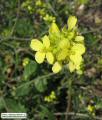 |
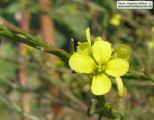 |
 |
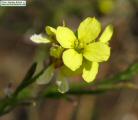 |
IMAGE: HFDIN-01 Photo of a flower cluster in situ. The cluster is not dense, containing only 3 to 5 flowers max. |
IMAGE: HFDIN-02 Close up photo of the 6mm diameter flower in situ. |
IMAGE: HFDIN-03 Close up photo of the flower in situ at a slightly lateral view to show reproductive organs. |
IMAGE: HFDIN-04 Close up photo of the flower which has 6 stamens, 4 long and central, and 2 short and lateral. |
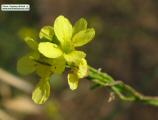 |
 |
 |
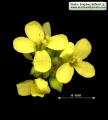 |
IMAGE: HFDIN-05 Close up photo of the flower in situ. Note the swollen green stigma. |
IMAGE: HFDIN-06 Photo of another flower of Hirschfeldia incana. |
IMAGE: HFDIN-07 Scanned and magnified image of the flower against a dark background. It consists of 4 cross shaped petals, 6 stamens and a central style + stigma slightly above the stamens. |
IMAGE: HFDIN-08 Scanned and magnified image of flowers against a dark background. |
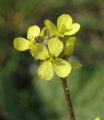 |
| |  |
IMAGE: HFDIN-09 Scanned and magnified image of flowers against a dark background. |
IMAGE: HFDIN-10 - |
IMAGE: HFDIN-11 - |
IMAGE: HFDIN-12 Photo of a lower leaf. It has several rounded lobes with the apical being the largest one. |
 |
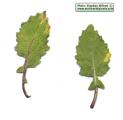 |
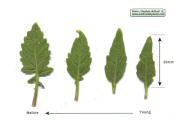 |
 |
IMAGE: HFDIN-13 Scanned image of adult basal leaves, with few deep lobes at their lower part and a well crenated outline. |
IMAGE: HFDIN-14 Scanned image of typical leaves, about 5 - 8 cm long. |
IMAGE: HFDIN-15 Scanned image of several leaves to show their gradual morphological changes with time. as it is shown they become more broad, lobed and attain a more crenated outline. |
IMAGE: HFDIN-16 Photo of a young plant, with numerous basal leaves and plenty of small yellow flowers. |
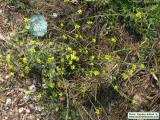 |
 |
 |
 |
IMAGE: HFDIN-17 Photo of a young plant. |
IMAGE: HFDIN-18 Photo of an adult plant, rather bushy with its highly branched stems and racemes and little amount of leaves. |
IMAGE: HFDIN-19 Photo of some plants along a roadside in the countryside. This is one of the common habitats of this plant. |
IMAGE: HFDIN-20 Scanned image of the flowering part of the plant which consists of highly branched racemes. |
 |
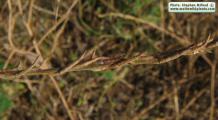 |
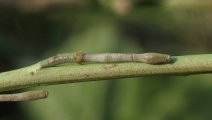 |
 |
IMAGE: HFDIN-21 Scanned image of a raceme which consists of a basal leaflet, several short pod-like fruit and a small cluster of small yellow flowers. |
IMAGE: HFDIN-22 Photo of seed pods (siliqua) in situ. |
IMAGE: HFDIN-23 Close up image of seed pod showing the swollen beak. This is an important identification feature to distinguish from the closely related Sisymbrium officinale which does not have beaked pods. |
IMAGE: HFDIN-24 Scanned image of several siliqua on the stem. They are appressed to the stem. |
 |
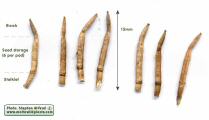 |
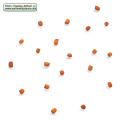 |
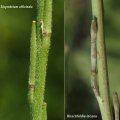 |
IMAGE: HFDIN-25 Scanned image of several siliqua on the stem. |
IMAGE: HFDIN-26 Another image of the glabrous silicule. |
IMAGE: HFDIN-27 Scanned and magnified image of the reddish brown cylindrical seeds, about 1mm long. |
IMAGE: HFDIN-28 Photos of the siliqua of Sisymbrium officinale and Hirschfeldia incana for comparison. The latter is not hairy (glabrous) and with a swollen beak. |
|
| | |

